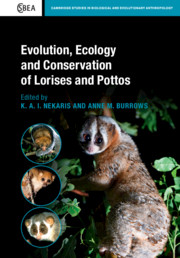Book contents
- Evolution, Ecology and Conservation of Lorises and Pottos
- Cambridge Studies in Biological and Evolutionary Anthropology
- Evolution, Ecology and Conservation of Lorises and Pottos
- Copyright page
- Dedication
- Contents
- Contributors
- Foreword
- Acknowledgements
- 1 Introduction
- Part I Evolution, Morphology and the Fossil Record
- 2 Sluggards and Drunkards?
- 3 What We Know (and Don’t Know) About the Fossil Records of Lorisids
- 4 Outliers
- 5 Molecular Advances in Lorisid Taxonomy and Phylogeny
- 6 The Toothcomb of Karanisia clarki
- 7 The Soft-Tissue Anatomy of the Highly Derived Hand of Perodicticus Relative to the More Generalised Nycticebus
- 8 Making Scents of Olfactory Sensitivity in Lorises and Pottos
- 9 Allometric and Phylogenetic Diversity in Lorisiform Orbit Orientation
- 10 The Evolution of Social Organisation in Lorisiformes
- 11 Biomechanics of Loris Locomotion
- 12 What Role Did Gum-Feeding Play in the Evolution of the Lorises?
- Part II Ecology and Captive Management
- Part III Research, Trade and Conservation
- References
- Index
3 - What We Know (and Don’t Know) About the Fossil Records of Lorisids
from Part I - Evolution, Morphology and the Fossil Record
Published online by Cambridge University Press: 29 February 2020
- Evolution, Ecology and Conservation of Lorises and Pottos
- Cambridge Studies in Biological and Evolutionary Anthropology
- Evolution, Ecology and Conservation of Lorises and Pottos
- Copyright page
- Dedication
- Contents
- Contributors
- Foreword
- Acknowledgements
- 1 Introduction
- Part I Evolution, Morphology and the Fossil Record
- 2 Sluggards and Drunkards?
- 3 What We Know (and Don’t Know) About the Fossil Records of Lorisids
- 4 Outliers
- 5 Molecular Advances in Lorisid Taxonomy and Phylogeny
- 6 The Toothcomb of Karanisia clarki
- 7 The Soft-Tissue Anatomy of the Highly Derived Hand of Perodicticus Relative to the More Generalised Nycticebus
- 8 Making Scents of Olfactory Sensitivity in Lorises and Pottos
- 9 Allometric and Phylogenetic Diversity in Lorisiform Orbit Orientation
- 10 The Evolution of Social Organisation in Lorisiformes
- 11 Biomechanics of Loris Locomotion
- 12 What Role Did Gum-Feeding Play in the Evolution of the Lorises?
- Part II Ecology and Captive Management
- Part III Research, Trade and Conservation
- References
- Index
Summary
Lorisidae is a group of strepsirrhines that comprises the Asian lorises, the African pottos (including angwantibos) and their closest fossil relatives. As a group, extant lorisids are not very speciose, with 15 species currently identified (10 species of loris and 5 of potto; see 2015). The biogeographic and phylogenetic contexts of the evolutionary origin of lorisids have long been a matter of debate, without any clear resolution (Pickford, 2012). The main reason why there are only slow improvements in this research area is because lorises are rare in the African and Asian fossil record. Only seven species have been named (Table 3.1), suggesting that either lorisids have been a poorly diverse group throughout their evolutionary history, or that there is a hidden lorisid diversity yet to be uncovered beneath the forests of continental Africa and South and South-east Asia.
- Type
- Chapter
- Information
- Publisher: Cambridge University PressPrint publication year: 2020

